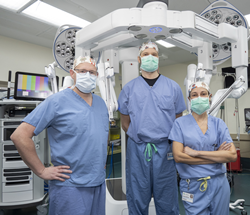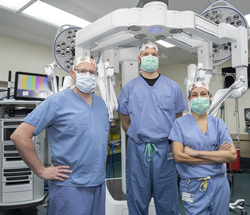
William Nelson, MD, Daniel Murariu, MD, MPH, MBA, FACS, and Andrea Moreira, MD, complete region’s first robot assisted DIEP procedure.
“We’re incredibly excited to offer our patients this state-of-the-art microsurgical technique for breast reconstruction after cancer,” said Dr. Moreira. “AHN brings together the technical expertise of its plastic and general surgeons to provide the optimal patient benefit and outcome.”
PITTSBURGH (PRWEB)
January 24, 2022
Allegheny Health Network (AHN) plastic and reconstructive surgeons at West Penn Hospital (WPH) are the first in western Pennsylvania and among the first in the country to perform robot assisted breast reconstructions using a patient’s own tissue in the lower abdomen. Known as a robotic deep inferior epigastric artery perforator (DIEP) flap procedure, this minimally invasive technique is the latest advancement in the field of reconstructive surgery for areas of the body affected by aggressive cancer therapies.
Breast cancer is the second most common cancer in American women—meaning about one in eight will develop breast cancer over her lifetime, according to the American Cancer Society (ACS). Each year, more than 100,000 women undergo mastectomy procedures to treat or prevent breast cancer. The removal of the breast tissue often leaves many to consider subsequent surgeries such as breast reconstruction.
Led by Andrea Moreira, MD, director of reconstructive breast surgery and Daniel Murariu, MD, MPH, MBA, FACS, director of microsurgery and lymphatic surgery, AHN surgeons use the da Vinci Xi® surgical system to harvest tissue, including blood vessels, skin, and fat, from the lower abdomen to rebuild the patient’s breast(s).
Christina “Tina” Jordan, a 54-year-old mother of three from Elizabeth, PA was diagnosed with cancer in October 2020. Nearly one year later, she’s cancer free and the first AHN patient to undergo a unilateral robot-assisted breast reconstruction at WPH.
“We’re incredibly excited to offer our patients this state-of-the-art microsurgical technique for breast reconstruction after cancer,” said Dr. Moreira. “For this multi-specialty procedure, AHN brings together the technical expertise of its plastic and general surgeons to provide the optimal patient benefit and outcome.”
In collaboration with the plastic surgeons, general surgeon William Nelson, MD, makes three, small (about 8 mm) incisions into the abdomen. The robot provides a magnified, high-definition 3-D vantage beneath the belly muscle. Through a special dye, Dr. Nelson can view the microvascular blood flow and perfusion in the tissue as they operate. Additional AHN surgeons with expertise in this portion of the procedure include board-certified colon and rectal surgeons Stanislav Nosik, MD, and Richard Fortunato, DO, who provide intraabdominal access for Dr. Murariu who then performs the vessel dissection.
Women undergoing reconstruction are often worried about the impact of the DIEP flap surgery to their core strength and comfort. “Without the robot, traditional DIEP reconstruction techniques require a long muscle incision, increasing the likelihood of longer hospital stays, heightened pain, and weakened abdominal walls,” said Dr. Nelson. “Now, most patients who undergo a robotic DIEP experience a faster recovery with less pain and minimal need for narcotic pain medicine.”
The robotic DIEP reconstruction can potentially decrease the chance of hernias or bulging in the abdomen compared to a standard non-robotic DIEP flap, as there is minimal disruption of the abdominal wall muscle and fascia. According to a study published in the Plastic and Reconstructive Surgery Journal, the use the robot to assist the DIEP flap harvest may be the next stage in the evolution of autologous breast reconstruction (Plastic and Reconstructive Surgery: “The Robotic DIEP Flap” doi: 10.1097/PRS.0000000000006529). The reported early experience with this technique suggests a reduction in postoperative pain, length of stay and enhanced overall recovery.
As the tissue is harvested from the abdomen and transferred to the patient’s chest, Dr. Moreira and Dr. Murariu conclude the reconstruction by reconnecting the DIEP flap blood vessels to the chest with the aid of a surgical microscope. Using a patient’s own tissue results in a more natural appearance and is a more permanent solution when compared to implant-based reconstructions, which can result in additional surgeries. To date, AHN doctors have performed 17 robotic-assisted DIEP reconstructions. All patients required fewer painkillers and were discharged in about three days after surgery.
AHN patients who undergo reconstructive procedures following cancer treatments are cared for by a compassionate, multidisciplinary team of oncologists and other caregivers from the AHN Cancer Institute. Clinicians from various cancer disciplines, including medical, surgical and radiation oncology, work together closely to determine the most effective course of treatment to meet a patients’ long-term health goals and needs.
For more information on the AHN Cancer Institute or to learn more about the AHN Plastic Surgery division, visit http://www.ahn.org.
About the Allegheny Health Network:
Allegheny Health Network (AHN.org), a Highmark Health company, is an integrated healthcare delivery system serving the greater Western Pennsylvania region. The Network is composed of 14 hospitals, ambulatory surgery centers, Health + Wellness Pavilions, an employed physician organization, home and community based health services, a research institute, and a group purchasing organization. The Network provides patients with access to a complete spectrum of advanced medical services, including nationally recognized programs for primary and emergency care, trauma care, cardiovascular disease, organ transplantation, cancer care, orthopedic surgery, neurology and neurosurgery, women’s health, diabetes, autoimmune disease and more. AHN employs approximately 21,000 people, has more than 2,500 physicians on its medical staff and serves as a clinical campus for Drexel University College of Medicine and the Lake Erie College of Osteopathic Medicine.
Share article on social media or email:

